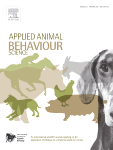Document type: Scientific article published in Animals
Authors: Alexandra Contreras-Jodar, Aranzazu Varvaró-Porter, Antonio Velarde, Virginie Michel
Preview: The prevalence and inter-observer repeatability of the four most valid and feasible indicators of consciousness after waterbath stunning in turkeys were evaluated before bleeding (i.e., tonic convulsion, breathing, spontaneous blinking and vocalization) and during bleeding (i.e., fluttering, breathing, spontaneous swallowing and head shaking). Furthermore, correlations between them were calculated to further understand the association between such indicators. This study compared the assessments of four observers on 7877 turkeys from 28 flocks slaughtered in eight different abattoirs. Repeatability between observers was assessed by combining the crude percentage of agreement and the Fleiss' kappa. Before bleeding, tonic seizure was observed to be not reliable under commercial conditions and spontaneous blinking and vocalization had poor repeatability. During bleeding, spontaneous swallowing was not observed and head shaking had poor repeatability. Hence, the most relevant indicators of consciousness before bleeding is breathing while during bleeding is breathing and wing flapping. Moreover, the stunning efficiency of the key electrical parameters used in the different slaughterhouses was assessed. Therefore, a refined list of indicators of the state of consciousness after waterbath stunning is proposed to be used in commercial turkey slaughterhouses to ensure consistency of controls. On the other hand, the range of the prevalence of turkeys with indicators of consciousness within a batch found before bleeding [0-16%] and after bleeding [0-18%] highlights the importance of controls.






